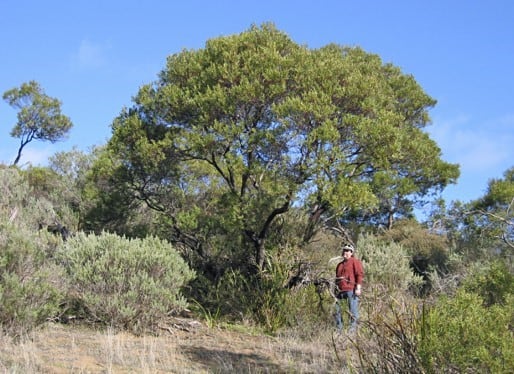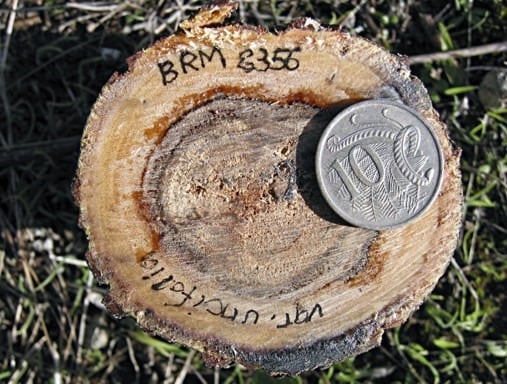Acacia uncifolia (J.M.Black) O’Leary
WATTLE
Acacias of Australia
Common Name
Summer Wattle, Wirilda, Coast Wirilda, Coastal Wirilda
Family
Fabaceae
Distribution
Disjunct in coastal and near-coastal areas when it occurs on Kangaroo Is. and southern Fleurieu Penin., S.A., near Torquay to Wilsons Promontory, Vic., and King and Flinders Islands, Tas.
Description
Bushy shrub or tree 5–10 m high, stems twisted, often spreading by runners and coppicing to form dense groves. Bark smooth, becoming longitudinally fissured with age, grey to dark brown. Branchlets glabrous. Phyllodes crowded on stems, 4–10 mm apart, oblanceolate to narrowly oblanceolate, (2.5–) 3–7.5 (–8) cm long, (2–) 3–10 (–15) mm wide, rather abruptly narrowed to a delicate, recurved-uncinate point, green to grey-green, glaucous, 1-nerved per face, obscurely penninerved; gland 0–8 mm above pulvinus. Inflorescences racemose; raceme axes 2–4 (–5) cm long; peduncles 2–5 mm long, glabrous; heads globular, (16–) 18–30 (–32)-flowered, pale yellow to cream. Flowers 5‑merous; sepals united; ovary with sparse to dense short hairs. Pods linear, to 16 cm long, 5–7 (–8) mm wide, firmly chartaceous. Seeds longitudinal, oblong to oblong-elliptic, 4–6 mm long, dark brown to black; funicle ¾ or more encircling seed, red-brown to blackish; aril clavate.
Habitat
Grows in sandy soils over limestone.
Specimens
S.A.: near Cygnet R., Kangaroo Is., G.Jackson 473 (AD); Port Lincoln, herb. R.Tate (AD97422170). Vic.: Cape Schanck area, c. 14 km due W of Flinders, B.R.Maslin 5473A (CANB, MEL, PERTH). Tas.: Currie, King Is., 28 Jan. 1971, P.Barnett s.n. (MEL).
Notes
Until recently regarded as a variety of A. retinodes but now considered more appropriately treated as a distinct species; see M.C.O’Leary, J. Adelaide Bot. Gard. 21: 102 (2007) for discussion.
A member of the ‘Acacia microbotrya group’, most closely related to A. retinodes which differs in its rough, different coloured bark, generally longer phyllodes, glabrous ovary and broader pods. Also closely related to A. provincialis which is most readily distinguished by its smooth, grey bark, often pruinose branchlets and phyllodes that are uncrowded on stems, more numerous flowers per head that are pale yellow to golden and glabrous ovary. See M.C.O’Leary, J. Adelaide Bot. Gard. 21: 97 Table 1 (2007), for additional differences.
Information on the biological and ecological features, and the utilisation potential, of this species is given in B.R.Maslin and M.W.McDonald, AcaciaSearch: Evaluation of Acacia as a woody crop option for southern Australia, RIRDC Publication No. 30/017, 186–189 (2004).
A detailed discussion of A. uncifolia (published as A. retinodes var. uncifolia) in Tasmania is given in A.J.J.Lynch (1993), Conserv. Biol. & Managem. of 16 Rare or Threat. Fabaceae Species Tas. (ANPWS Endangered Species Program Project No. 4: 41–47, 1993). It should be noted, however, that the flowering branch shown in Figure 5.1 of that work depicts A. retinodes.
Conservation
Superficially resembling A. alcockii which differs in its wider phyllodes, larger number of flowers per head, and pods with seed transversely orientated; occurrences of A. uncifolia (syn. A. retinodes var. uncifolia) on southern Eyre Penin., noted by B.R.Maslin, Fl. Australia 11A: 283 (2001), are now referable to A. alcockii. Phyllodes sometimes similar to those of A. flocktoniae (N.S.W.) and A. euthycarpa.
FOA Reference
Data derived from Flora of Australia Volumes 11A (2001), 11B (2001) and 12 (1998), products of ABRS, ©Commonwealth of Australia
Author
Revised by B.R.Maslin & M.O'Leary
B.R.Maslin
This identification key and fact sheets are available as a mobile application:
URL: https://apps.lucidcentral.org/wattle/
© Copyright 2018. All rights reserved.










